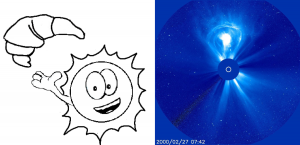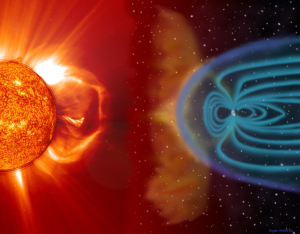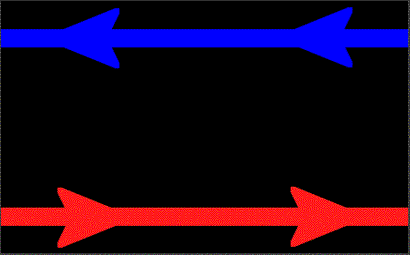Could you imagine your life without the Sun? No, and that is because there would be no life on Earth. Actually, there would be no solar system either. The Sun, however, does much more than that. It constantly affects the environment of the entire solar system, which means the Earth’s environment as well. The Sun is a very active star, and its activity is extremely varied and complicated, and not fully understood yet. What we know is that solar activity is mainly related to the Sun’s complex magnetic field.
The most spectacular phenomena related to solar activity are coronal mass ejections (CMEs). They are huge and powerful eruptions of plasma and magnetic field that are ejected from the Sun out into the solar system. CMEs are also the main drivers of magnetic storms at the Earth and at the other planets. A magnetic storm is a temporary disturbance of a planet’s magnetic field that interacts with a planet’s environment and causes various effects. A useful term in space physics is “space weather”. Space weather refers to the effects of the Sun and its magnetic field on interplanetary space and on the planets. This means that space weather can affect the environment around the Earth, and in turn space- and ground- based technological systems. However, do not worry, space weather effects are not rare at all, and they do not cause harm to human life on Earth (they can however be dangerous to human life in space). Solar storms are actually coming to us quite frequently, and they can result in beautiful auroras visible at high latitudes around both of Earth’s poles.

Aurora in Loppi (Finland) on 17 March 2015. Image credit: Juhana Lankinen.
Now, time for some breaking news: not every CME causes a magnetic storm on Earth. This is because our planet’s response to CMEs varies widely and depends on several factors: how strong the magnetic field of the impacting CME is, which part of the CME is crossed by Earth’s orbit, what the orientation of the magnetic field is within the CME, and so on. If two CMEs have the same structure but different field strengths, the stronger one will provoke a greater magnetic storm on Earth. So it is straightforward to assume that a stronger magnetic field will provoke stronger magnetic storms. To understand how the path of Earth through a CME affects the resulting space weather effects, it is practical to think of a CME as a huge croissant that expands with both ends initially attached to the Sun. With this picture in mind, it is intuitive to assume that the (magnetically speaking) strongest part of a CME is its nose, that is, the “fat” section of the croissant. This means that a “leg encounter” (which means that Earth encounters a CME only from its side) is expected to cause smaller space weather effects than a frontal encounter.

Left: How a CME looks like. Image credit: Ferdinando Palmerio. Right: How a CME really looks like. This picture is taken with a coronagraph, which is a telescope that can look at the solar corona by creating an artificial eclipse that hides the bright solar disc. The Sun corresponds to the white circle. Image credit: SOHO/LASCO (NASA/ESA).
Now, how the orientation of the magnetic field in a CME plays a role in space weather is a bit more complicated. The Earth is not completely unprotected from violent magnetic solar activity. Our planet has a protective magnetic bubble around its atmosphere, called the magnetosphere. It protects us from the charged particles coming from the Sun. These harmful particles can only penetrate our protective bubble when the magnetic fields of the magnetosphere and of a CME are antiparallel (that means, parallel but oriented in opposite directions). In such case, the magnetosphere opens while joining its magnetic field with the CME. This process is called magnetic reconnection. If you want to see what happens when a CME causes magnetic reconnection at Earth’s magnetosphere and how auroras are formed, check this video from NASA.


Left: Artistic view of a CME interacting with the magnetosphere. Image credit: Steele Hill (NASA). Right: How magnetic reconnection works. Image credit: Center for Visual Computing, University of California Riverside.
You should now have all the basic knowledge to understand what is meant by “solar superstorm”. A superstorm is an exceptionally powerful magnetic storm, known also as Carrington-like event. This name comes from the famous solar storm of 1859, that hit the Earth in only 17.6 hours from its eruption (a CME normally takes 2-4 days to reach Earth). The amateur astronomer Richard Carrington was looking at the Sun through his telescope, and he observed something that he described as “two patches of intensely white and bright light”. He observed a solar flare for the first time. The Carrington storm’s aurora was visible for three consecutive nights, and it was observed as far south as Colombia!
Aurora is caused by electrically charged particles released from the Sun into our atmosphere. Since there are so many charged particles in the atmosphere, they induce a current on long electrical wires below them. In 1859, this meant that telegraph communications all around the world began to fail. If such a storm would hit us now, the damage to telecommunications systems around the world would be much more severe. The systems that would take the most damage and fail are satellites (including communication and GPS ones) and power grids. We would be out of power for several hours, and the economic impact worldwide would be enormous.
This raises an obvious and important question: can we predict solar superstorms? Unfortunately we cannot predict when a storm will erupt from the Sun. However, it is intuitive to think that once we observe one we should be able to predict its arrival at the Earth, right? The answer is not that simple, since there are many factors contributing to the speed and direction of CMEs. One great example is the solar superstorm of 2012. An unusually large storm (a Carrington-like event) erupted in July 2012, and it was believed to be directed towards the Earth. The CME, however, just missed us, and caused no damage to our electrical systems. This shows that we cannot predict how a CME evolves while travelling through the solar system, either. So, what should we do? For the time being, we can hope that forecasting tools will be improved and/or that a solar superstorm will not hit us in the near future. On the other hand, if a superstorm does hit us, we need to be prepared. This means backup systems for our power grids and ability to handle sudden influxes of currents.
Written by Erika Palmerio